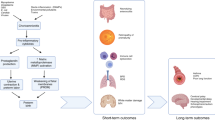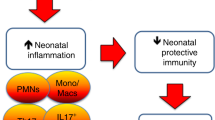Abstract
Causal, cellular, and inflammatory links between choriodecidual infection with group B streptococcus (GBS) and preterm labor were assessed in a nonhuman primate model. Rhesus monkeys received varying doses of a clinical isolate of GBS, type III or saline, via an indwelling catheter placed between the chorion/decidua and myometrium in the lower pole of the uterus. Choriodecidual inoculation of GBS was followed by a graded response in amniotic fluid (AF) leukocytes, proinflammatory cytokines, prostaglandin E2 and F2α, and uterine activity (P < .05). The magnitude of the inflammatory response in AF was related, in part, to the initial inoculum size and whether AF cultures remained negative or became positive for GBS. Microbial invasion ofAF was associated with advanced inflammation and preterm labor. We provide experimental evidence that chorio deciduitis is a transitional stage of intrauterine infection, which may be self-limited, remain dormant, or progress to intraamniotic infection. These data, coupled with clinical observations, suggest that choriodecidual inflammation is an antecedent event in the pathogenesis of premature cervical ripening functional cervical insufficiency), premature rupture of the fetal membranes, or preterm labor.
Similar content being viewed by others
References
Hillier SL, Martius J, Krohn M, Kiviat N, Holmes KK, Eschenbach DA. A case-control study of chorioamnionic infection and histologic chorioamnionitis in prematurity. N Engl J Med. 1988;319(15):972–978.
Romero R, Mazor M. Infection and preterm labor. Clin Obstet Gynecol. 1988;31(3):553–584.
Goldenberg RL, Culhane JF, Iams JD, Romero R. Epidemiology and causes of preterm birth. Lancet. 2008;371(9606):75–84.
Romero R, Espinoza J, Goncalves LF, Kusanovic JP, Friel LA, Nien JK. Inflammation in preterm and term labour and delivery. Semin Fetal Neonatal Med. 2006;11(5):317–326.
Cassell GH, Waites KB, Crouse DT. Mycoplasmal infections. In: Remington JS, Klein JO, eds. Infectious Diseases of the Fetus and Newborn Infant. Philadelphia, PA: W. B. Saunders Co., Inc; 2001:733–767.
Davies JK, Shikes RH, Sze CI, et al. Histologic inflammation in the maternal and fetal compartments in a rabbit model of acute intra-amniotic infection. Am J Obstet Gynecol. 2000; 183(5):1088–1093.
Gibbs RS, Blanco JD, St Clair PJ, Castaneda YS. Quantitative bacteriology of amniotic fluid from women with clinical intraamniotic infection at term. J Infect Dis. 1982;145(1):1–8.
McDonald HM, O’Loughlin JA, Jolley P, Vigneswaran R, McDonald PJ. Vaginal infection and preterm labour. Br J Obstet Gynaecol. 1991;98(5):427–435.
Cassell GH, Andrew W, Haut J. Isolation of micro-organisms from chorioamnion is twice that from amniotic fluid at cesarean delivery in women with intact membranes. Am J Obstet Gynecol, 1993;168(1):p.424.
Elovitz MA, Mrinalini C. Animal models of preterm birth. Trends Endocrinol Metab. 2004;15(10):479–487.
Gravett MG, Witkin SS, Haluska GJ, Edwards JL, Cook MJ, Novy MJ. An experimental model for intraamniotic infection and preterm labor in rhesus monkeys. Am J Obstet Gynecol. 1994;171(6):1660–1667.
Gravett MG, Novy MJ, Rosenfeld RG, et al. Diagnosis of intra-amniotic infection by proteomic profiling and identification of novel biomarkers. JAMA. 2004;292(4):462–469.
Gravett MG, Thomas A, Schneider KA, et al. Proteomic analysis of cervical-vaginal fluid: identification of novel biomarkers for detection of intra-amniotic infection. J Proteome Res. 2007;6(1):89–96.
Gravett MG, Adams KM, Sadowsky DW, et al. Immunomodulators plus antibiotics delay preterm delivery after experimental intraamniotic infection in a nonhuman primate model. Am J Obstet Gynecol. 2007;197(5):518e1–518e8.
Vadillo-Ortega F, Sadowsky DW, Haluska GJ, et al. Identification of matrix metalloproteinase-9 in amniotic fluid and amniochorion in spontaneous labor and after experimental intrauterine infection or interleukin-1 beta infusion in pregnant rhesus monkeys. Am J Obstet Gynecol. 2002;186(1): 128–138.
Bethea CL, Gravett MG, Sadowsky DW, et al. Amniotic fluid prolactin is decreased by experimental intrauterine infection or interleukin-1beta infusion but not via prostaglandins in pregnant rhesus macaques. Biol Reprod. 1998;58(6): 1385–1393.
Sadowsky DW, Adams KM, Gravett MG, Witkin SS, Novy MJ. Preterm labor is induced by intraamniotic infusions of interleukin-1beta and tumor necrosis factor-alpha but not by interleukin-6 or interleukin-8 in a nonhuman primate model. Am J Obstet Gynecol. 2006;195(6):1578–1589.
Gravett MD, Witkin SS, Novy MJ. A nonhuman primate model for chorioamnionitis and preterm labor. Sem Reprod Endocrinol. 1994;12(4):246–262.
Gray DJ, Robinson HB, Malone J, Thomson RB Jr. Adverse outcome in pregnancy following amniotic fluid isolation of Ureaplasma urealyticum. Prenat Diagn. 1992;12(2): 111–117.
Yellon SM, Mackler AM, Kirby MA. The role of leukocyte traffic and activation in parturition. J Soc Gynecol Investig. 2003;10(6):323–338.
Menon R, Fortunato SJ. The role of matrix degrading enzymes and apoptosis in rupture of membranes. J Soc Gynecol Investig. 2004;11(7):427–437.
Zaga-Clavellina V, Merchant-Larios H, Garcia-Lopez G, Maida-Claros R, Vadillo-Ortega F. Differential secretion of matrix metalloproteinase-2 and –9 after selective infection with group B streptococci in human fetal membranes. J Soc Gynecol Investig. 2006;13(4): 271–279.
Kelly RW. Inflammatory mediators and cervical ripening. J Reprod Immunol. 2002;57(1–2):217–224.
Cox SM, King MR, Casey ML, MacDonald PC. Interleukin-1 beta, -1 alpha, and –6 and prostaglandins in vaginal/cervical fluids of pregnant women before and during labor. J Clin Endocrinol Metab. 1993;77(3):805–815.
Malak TM, Bell SC. Structural characteristics of term human fetal membranes: a novel zone of extreme morphological alteration within the rupture site. Br J Obstet Gynaecol. 1994;101(5):375–386.
El Khwad M, Stetzer B, Moore RM, et al. Term human fetal membranes have a weak zone overlying the lower uterine pole and cervix before onset of labor. Biol Reprod. 2005; 72(3):720–726.
Reti NG, Lappas M, Riley C, et al. Why do membranes rupture at term? Evidence of increased cellular apoptosis in the supracervical fetal membranes. Am J Obstet Gynecol. 2007; 196(5):484e1–484e10.
Shim SS, Romero R, Hong JS, et al. Clinical significance of intra-amniotic inflammation in patients with preterm premature rupture of membranes. Am J Obstet Gynecol. 2004;191(4): 1339–1345.
Lee SE, Romero R, Jung H, Park CW, Park JS, Yoon BH. The intensity of the fetal inflammatory response in intraamniotic inflammation with and without microbial invasion of the amniotic cavity. Am J Obstet Gynecol. 2007;197(3): 294e1–294e6.
Rizzo G, Capponi A, Vlachopoulou A, Angelini E, Grassi C, Romanini C. Ultrasonographic assessment of the uterine cervix and interleukin-8 concentrations in cervical secretions predict intrauterine infection in patients with preterm labor and intact membranes. Ultrasound Obstet Gynecol. 1998; 12(2):86–92.
Andrews WW, Hauth JC, Goldenberg RL, Gomez R, Romero R, Cassell GH. Amniotic fluid interleukin-6: correlation with upper genital tract microbial colonization and gestational age in women delivered after spontaneous labor versus indicated delivery. Am J Obstet Gynecol. 1995;173(2):606–612.
Holst RM, Mattsby-Baltzer I, Wennerholm UB, Hagberg H, Jacobsson B. Interleukin-6 and interleukin-8 in cervical fluid in a population of Swedish women in preterm labor: relationship to microbial invasion of the amniotic fluid, intra-amniotic inflammation, and preterm delivery. Acta Obstet Gynecol Scand. 2005;84(6):551–557.
Jacobsson B. Intra-amniotic infection and inflammation in preterm birth—is bacteria always the connection? Commentary on the article by Miralles et al. on page 570. Pediatr Res. 2005;57(4):473–474.
Zaga-Clavellina V, Garcia-Lopez G, Flores-Herrera H, et al. In vitro secretion profiles of interleukin (IL)–1beta, IL-6, IL-8, IL-10, and TNF alpha after selective infection with Escherichia coli in human fetal membranes. Reprod Biol Endocrinol, 2007;13(5):p.46.
Steel JH, Malatos S, Kennea N, et al. Bacteria and inflammatory cells in fetal membranes do not always cause preterm labor. Pediatr Res. 2005;57(3):404–411.
Park CW, Moon KC, Park JS, Jun JK, Romero R, Yoon BH. The involvement of human amnion in histologic chorioamnionitis is an indicator that a fetal and an intra-amniotic inflammatory response is more likely and severe: clinical implications. Placenta. 2009;30(1):56–61.
Gomez R, Romero R, Medina L, et al. Cervicovaginal fibronectin improves the prediction of preterm delivery based on sonographic cervical length in patients with preterm uterine contractions and intact membranes. Am J Obstet Gynecol. 2005;192(2):350–359.
Buhimschi IA, Jabr M, Buhimschi CS, Petkova AP, Weiner CP, Saed GM. The novel antimicrobial peptide beta3-defensin is produced by the amnion: a possible role of the fetal membranes in innate immunity of the amniotic cavity. Am J Obstet Gynecol. 2004;191(5):1678–1687.
Espinoza J, Chaiworapongsa T, Romero R, et al. Antimicrobial peptides in amniotic fluid: defensins, calprotectin and bacterial/permeability-increasing protein in patients with microbial invasion of the amniotic cavity, intra-amniotic inflammation, preterm labor and premature rupture of membranes. J Matern Fetal Neonatal Med. 2003;13(1):2–21.
Galask R, Varner M, Petzold C, Wilbur S. Bacterial attachment to the chorioamniotic membranes. Am J Obstetr Gynecol. 1984;148(7):915–926.
Winram SB, Jonas M, Chi E, Rubens CE. Characterization of group B streptococcal invasion of human chorion and amnion epithelial cells in vitro. Infect Immun. 1998;66(10): 4932–4941.
Kjaergaard N, Helmig RB, Schonheyder HC, Uldbjerg N, Hansen ES, Madsen H. Chorioamniotic membranes constitute a competent barrier to group b streptococcus in vitro. Eur J Obstet Gynecol Reprod Biol. 1999;83(2):165–169.
Gyr TN, Malek A, Mathez-Loic F, et al. Permeation of human chorioamniotic membranes by Escherichia coli in vitro. Am J Obstet Gynecol. 1994;170(1 pt 1):223–227.
Cassell GH, Davis RO, Waites KB, et al. Isolation of Mycoplasma hominis and Ureaplasma urealyticum from amniotic fluid at 16–20 weeks of gestation: potential effect on outcome of pregnancy. Sex Transm Dis. 1983;10(4 suppl): 294–302.
Waites KB, Katz B, Schelonka RL. Mycoplasmas and ureaplasmas as neonatal pathogens. Clin Microbiol Rev. 2005;18(4):757–789.
Waites KB, Schelonka RL, Xiao L, Grigsby PL, Novy MJ. Congenital and opportunistic infections: Ureaplasma species and Mycoplasma hominis. Semin Fetal Neonatal Med, 2009; 14(4):p.190.
Lockwood CJ, Paidas M, Krikun G, et al. Inflammatory cytokine and thrombin regulation of interleukin-8 and intercellular adhesion molecule-1 expression in first trimester human decidua. J Clin Endocrinol Metab. 2005;90(8):4710–4715.
Bryant-Greenwood GD, Kern A, Yamamoto SY, Sadowsky DW, Novy MJ. Relaxin and the human fetal membranes. Reprod Sci. 2007;14(8 suppl):42–45.
Lockwood CJ. Biochemical markers of preterm delivery. In: Petraglia F et al, eds. Preterm Birth: Mechanisms, Mediators, Prediction, Prevention and Interventions. United Kingdom: Informa Healthcare; 2007:115–130.
Keeler SM, Roman AS, Coletta JM, Kiefer DG, Feuerman M, Rust OA. Fetal fibronectin testing in patients with short cervix in the midtrimester: can it identify optimal candidates for ultrasound-indicated cerclage? Am J Obstet Gynecol. 2009; 200(2):158e1–158e6.
Christiaens I, Zaragoza DB, Guilbert L, Robertson SA, Mitchell BF, Olson DM. Inflammatory processes in preterm and term parturition. J Reprod Immunol. 2008;79(1):50–57.
Author information
Authors and Affiliations
Corresponding author
Rights and permissions
About this article
Cite this article
Grigsby, P.L., Novy, M.J., Waldorf, K.M.A. et al. Choriodecidual Inflammation: A Harbinger of the Preterm Labor Syndrome. Reprod. Sci. 17, 85–94 (2010). https://doi.org/10.1177/1933719109348025
Published:
Issue Date:
DOI: https://doi.org/10.1177/1933719109348025




